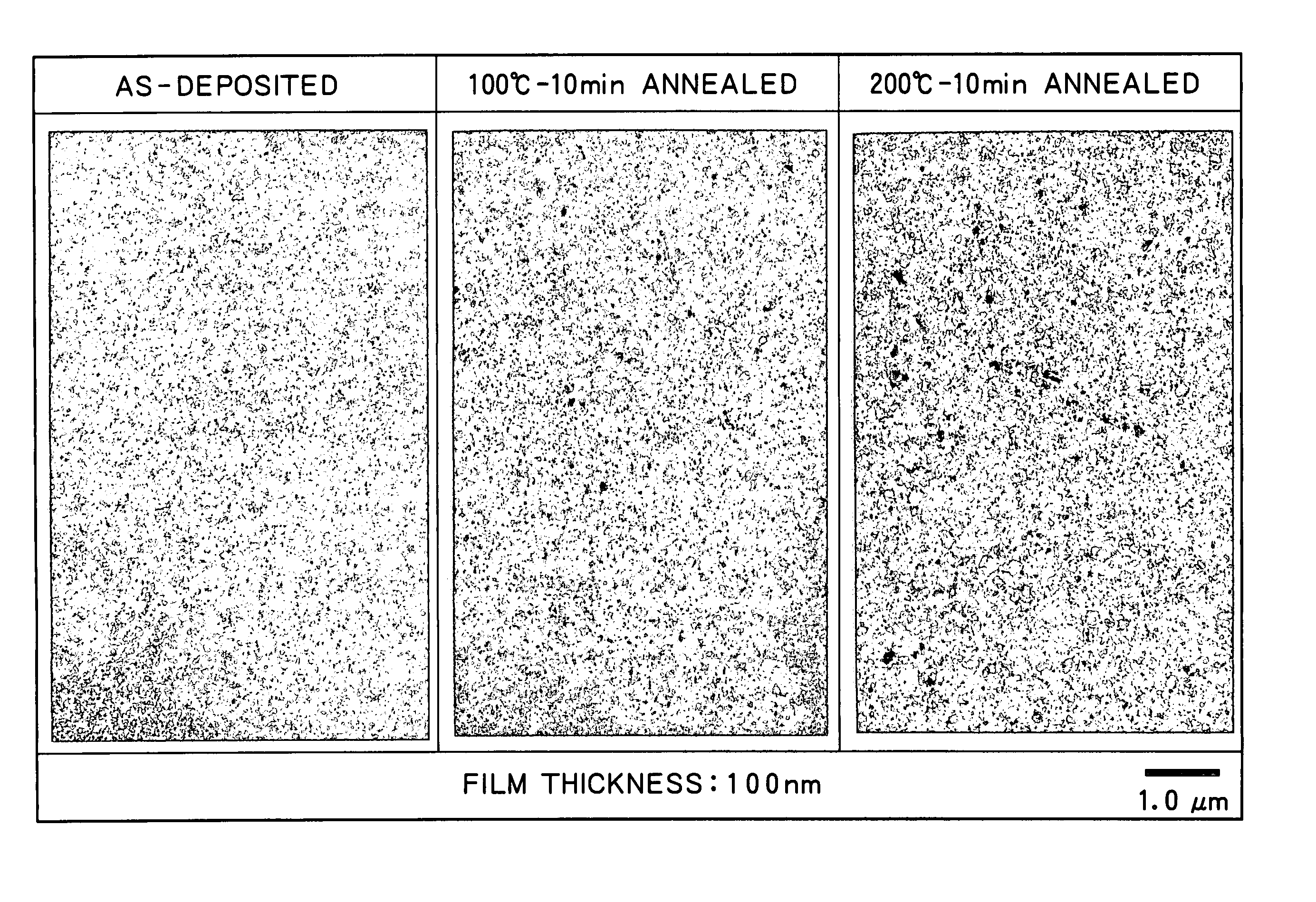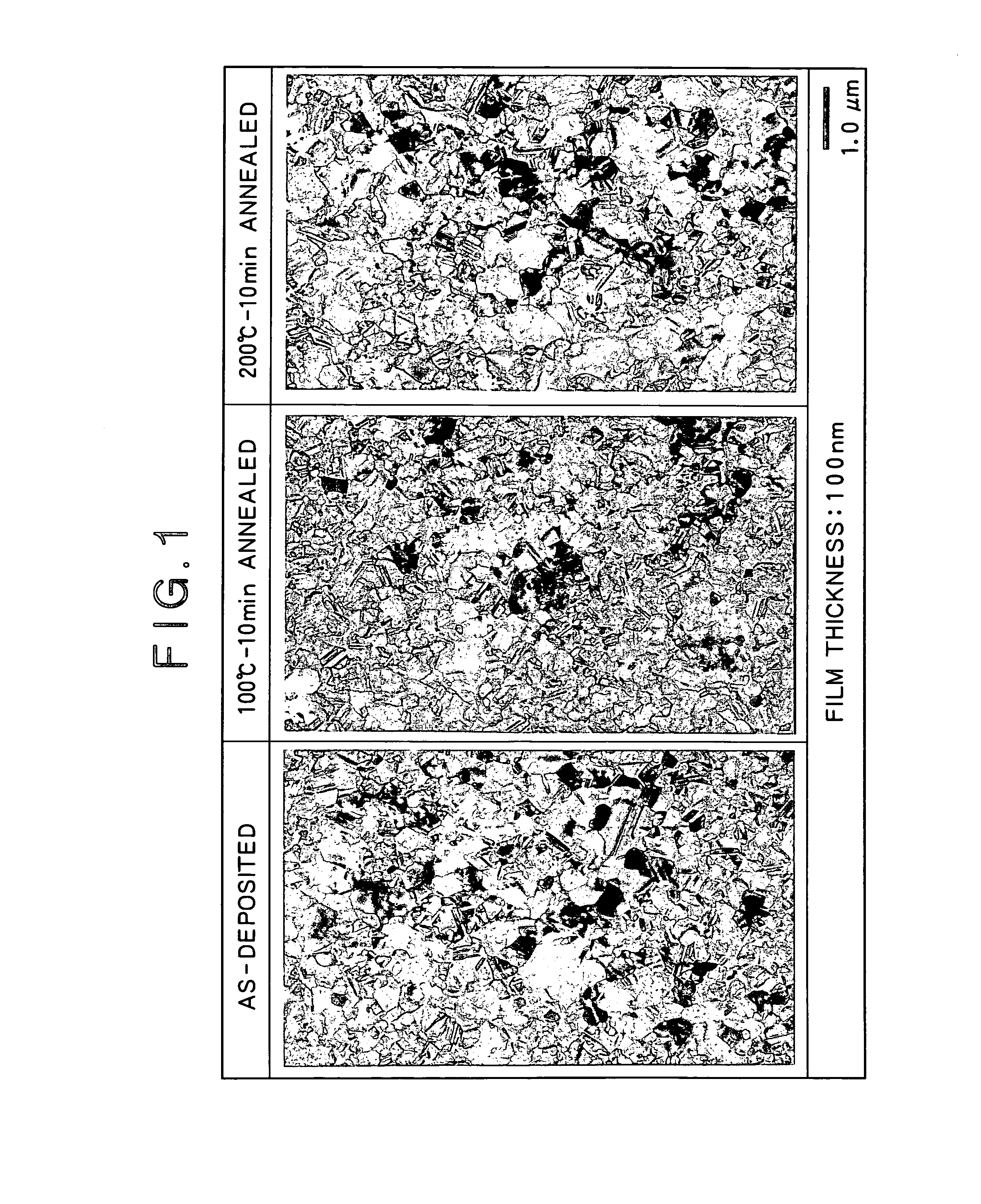Reflective film, reflection type liquid crystal display, and sputtering target for forming the reflective film
a technology of liquid crystal display and reflective film, which is applied in the field of reflective film, can solve the problems of ag grain growth, ag coalescence, ag oxidation of ag film, and gradual decrease of reflectivity, and achieve the effect of improving anti-oxidation property and initial high reflectivity of ag
- Summary
- Abstract
- Description
- Claims
- Application Information
AI Technical Summary
Benefits of technology
Problems solved by technology
Method used
Image
Examples
experiment example 1
[0039]Study was conducted to evaluate the influence of the amount of Nd in a binary alloy comprising Ag and Nd on reflectivity. Using a target comprising the compositions shown in Table 1, a reflective film of 1500 Å in thickness was formed on a glass substrate by DC magnetron sputtering. Initial reflectivity of each specimen was determined by visible ultraviolet ray spectrophotometer (Shimadzu Corporation). The results are shown in Table 1. In Table 1, the value of “Io (Ag-base alloy) −Io (pure Ag)” is expressed as rate of change (%) of the initial reflectivity where Io (pure Ag) (%) is initial reflectivity of a reflective film containing Ag only (Nd added in an amount of 0%) and Io (Ag-base alloy) (%) is initial reflectivity measured of each specimen. Using the above specimens, an acceleration test was performed under environmental conditions where grain growth of Ag or coalescence of Ag atoms is likely to occur. In the acceleration test, a glass substrate with the reflective film...
experiment example 2
[0042]The experiment was performed by the same procedure on a binary alloy comprising Ag and Y, and the rate of change of initial reflectivity and the rate of change of reflectivity over time were determined. The results are shown in Table 2. The results similar to those of the experiment on Ag—Nd alloy were obtained. However, it is evident that Y's effect of suppressing the change over time was weaker compared with the case where Nd was used.
[0043]
TABLE 2Ag—Y alloyRate of change ofRate of changeAdded amount ofinitialover time ofY (%)reflectivity (%)reflectivity * (%)00−7.00.1−0.1−1.80.3−0.5−1.50.5−0.8−1.50.7−1.0−1.50.9−1.0−1.41.0−1.2−1.32.0−1.5−1.03.0−2.0−1.03.5−2.5−1.0* Rate of change before and after leaving the specimen under the conditions of 80° C. and 90% RH for 48 hours
experiment example 3
[0044]The experiment was performed by the same procedure on a binary alloy comprising Ag and Ce, and the rate of change on initial reflectivity and the rate of change over time of reflectivity were determined. The results are shown in Table 3. The results were similar to those of Ag—Nd alloy. However, it is evident that Ce's effect of suppressing the rate of change over time was weaker than that of Nd.
[0045]
TABLE 3Ag—Ce alloyRate of change ofRate of changeAdded amount ofinitialover time ofCe (%)reflectivity (%)reflectivity * (%)00−7.00.1−0.1−2.00.3−0.5−1.70.5−0.8−1.70.7−1.0−1.70.9−1.0−1.61.0−1.2−1.52.0−1.5−1.23.0−2.0−1.23.5−2.5−1.2* Rate of change before and after leaving the specimen under the conditions of 80° C. and 90% RH for 48 hours
PUM
| Property | Measurement | Unit |
|---|---|---|
| Temperature | aaaaa | aaaaa |
| Fraction | aaaaa | aaaaa |
| Fraction | aaaaa | aaaaa |
Abstract
Description
Claims
Application Information
 Login to View More
Login to View More - R&D
- Intellectual Property
- Life Sciences
- Materials
- Tech Scout
- Unparalleled Data Quality
- Higher Quality Content
- 60% Fewer Hallucinations
Browse by: Latest US Patents, China's latest patents, Technical Efficacy Thesaurus, Application Domain, Technology Topic, Popular Technical Reports.
© 2025 PatSnap. All rights reserved.Legal|Privacy policy|Modern Slavery Act Transparency Statement|Sitemap|About US| Contact US: help@patsnap.com



